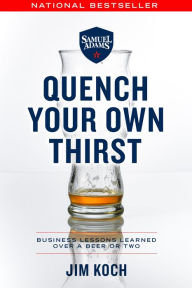Tony Magee is the founder and CEO of the Lagunitas Brewing Company.
So You Want to Start a Brewery?: The Lagunitas Story
by Tony Magee
Paperback
- ISBN-13: 9781556525629
- Publisher: Chicago Review Press, Incorporated
- Publication date: 10/01/2014
- Pages: 224
- Sales rank: 184,643
- Product dimensions: 6.00(w) x 8.90(h) x 0.60(d)
.
In 1993, Tony Magee, who had foundered at every job he’d ever had, decided to become the founder of a brewery. So You Want to Start a Brewery? is the thrilling first-person account of his gut-wrenching challenges and unexpected successes.
Based in Petaluma, California, the Lagunitas Brewing Company makes craft beer that is simple and flavorful and defies categorization. The same could be said for this book. Equal parts memoir, narrative, and business story—with liberal dashes of pop culture and local color—this honest yet hilarious account of a one-of-a-kind, made-in-America journey just happens to culminate with the success of one of the nation’s most popular craft beer brands. In twenty years, Lagunitas has grown from a shoestring operation to be the fifth largest—and the fastest growing—craft brewer in the United States.
First published in a limited edition two years ago by a tiny California press, So You Want to Start a Brewery? has here been revised and updated to include Lagunitas’s establishment of a new brewery in Chicago, set to open in 2014. So You Want to Start a Brewery? is unglamorous and full of entertaining digressions, but it’s never afraid to mess with the nuts and bolts. This is a must-read for all who have considered starting their own business—or have sweated blood working to get one on its feet. Told in the vibrant voice of Tony Magee—the man closest to the process—this blow-by-blow chronicle will introduce beer drinkers and entrepreneurs to the reality of starting a craft brewery from the ground up.
Customers Who Bought This Item Also Bought
-
- Brewing Up a Business:…
- by Sam Calagione
-
- Hatching Twitter: A True Story…
- by Nick Bilton
-
- The Revenge of Analog: Real…
- by David Sax
-
- Start Your Own Microbrewery,…
- by Entrepreneur Media StaffCorie Brown
-
- Disrupted: My Misadventure in…
- by Dan Lyons
-
- Chocolate Wars: The 150-Year…
- by Deborah Cadbury
-
- Email Essentials: How to Write…
- by Shirley Taylor
-
- Quench Your Own Thirst:…
- by Jim Koch
-
- Netflixed: The Epic Battle for…
- by Gina Keating
-
- Ultimate Guide to YouTube for…
- by Oliver NorthJason R. Rich
-
- How to Start a Home-Based…
- by Jill S. Moran
-
- Ultimate Guide to Local…
- by Perry MarshallTalor ZamirNyagoslav ZhekovGarrett French
Recently Viewed
“If you really want to understand what makes craft brewing fundamentally different and more recklessly thrilling than its plodding industrial counterparts, it's hard to find a better spirit guide than Tony Magee. This is not a how-to business book, but a stream-of-consciousness sermon on one man’s ongoing trip into the unknown as he creates and continues to shape the destiny of one of the more iconic craft beer brands anywhere. There's no glib advice here. Tony insists that we all find our own unique way to success, but it sure is enlightening being along with him for the ride.” —Randy Mosher, author of Tasting Beer
“Forget the title—this book will be as interesting to a teetotaler as it is to a beer geek. In So You Want To Start A Brewery, Lagunitas founder Tony Magee waxes poetic about the beginning days of Lagunitas. It really has nothing to do with brewing beer. It’s all about taking chances, and the trials and tribulations that inevitably follow. If anything, it’s an adventure story. I received a copy and was blown away at how much fun the writing is in this book." —Paste magazine
"Magee’s account of the company’s founding – and near-floundering – reads less like a dry history than a breathless adventure script. With candid honesty throughout, there is no denying that this is a story from the heart." —ChicagoFoodies.com
“Documents the seemingly simple but uniquely savvy thinking Magee used to turn a six-barrel brewhouse into a top craft brewer. Instructive and inspiring for entrepreneurs of all stripes.” —Ray Daniels, director, Cicerone Certification Program, and author of Designing Great Beers
“A must read for aspiring brewers, beer aficionados, and entrepreneurs alike. This is a tale of perseverance and patience; creativity and wisdom; innovation and insight; and shared through the lens of an unlikely beer genius who cultivates his brand through a symphonic approach.” —Brett Joyce, president, Rogue Ales
“Like the beer of the brewery he founded, Tony Magee’s voice is original and provocative. Read this book.” —Tom Acitelli, author of The Audacity of Hops
“All brewers think they can write, but Tony brings his unique and entertaining beer story to life in such a funny, breezy, yet thoughtful way that reading it feels like you’re having one of his IPA’s with Hemingway and Gore Vidal in a Key West bar. I read it cover to cover in one sitting and found myself laughing out loud throughout.” —Harry Schuhmacher, publisher, Beer Business Daily
“Unconventional brands come from unconventional people. Drawing from music and literature, Tony Magee sees the world in a way that most completely miss. He has poured his heart and soul into Lagunitas and we are all richer for it.” —Keith Greggor, co-owner & CEO, Anchor Brewing Company
“Tony is one of the most unique characters in all of craftdom, rising fast to become one of the top US craft brewers in recent years. He’s wicked smart and has a way with words; here’s his story told in his own inimitable fashion.” —Benj Steinman, Beer Marketer’s Insights
"Highly recommended for readers who are interested in beer, business tales, or even humorous and narrative American nonfiction." —Library Journal
"Tony Magee is quite the craftsman, not only with beer, but also with this wonderful and revealing read. Magee is as much an artist with words as he is with malt and hops." —All About Beer magazine
"Magee's writing, an entertaining and at times hilarious mix of Hunter S. Thompson gonzo-babble and Neil Young Waging Heavy Peace stream of consciousness, grabs the reader by the cojones (and if you weren't endowed with them, you acquire them quickly) and drags them along the cacophony of trials and tribulations rendering the biblical Job something of a slacker. Spoiler alert: it all works out. Somehow. Get this book." —Celebrator Beer News
Magee, owner of Lagunitas Brewing in Petalumas, CA, brings up to date his rollicking history of the brewery, founded during the rise of American craft brewing in the 1990s. Luckily for beer aficionados, the author managed to survive the difficulties that often accompany starting a business. Not only surviving, the Lagunitas brewery has thrived and created higher-end beers with its own distinct style that continues to draw in new fans. Magee's writing is easygoing and often pleasantly digressive, highlighting his philosophy and the brewery's business relationships, which include many great friendships; assets that have carried him through both difficult and prosperous times. Sprinkled throughout are short commentaries written by relatives and friends on Magee and his brewery. The chronicle is at its best when the author discusses the people who have shaped his company. Overall, this leads to a pleasurable read—with only a few tangents that seem more distracting than illuminating. VERDICT Highly recommended for readers who are interested in beer, business tales, or even humorous and narrative American nonfiction.—Ginny Wolter, Toledo-Lucas Cty. P.L.













